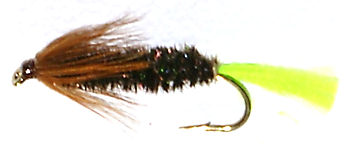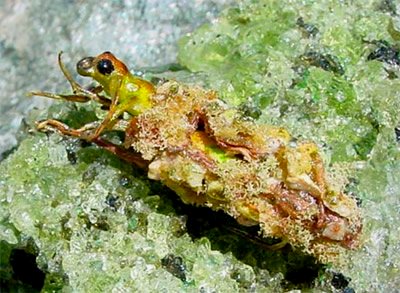Stick Fly Cased Caddis Sedge Larvae
When food is scarce then Rainbow and Brown trout will hunt on the bottom of the river or lake for cased caddis. They may have to dislodge some of the stones and other debris to find them but to the trout this extra effort normally brings results.

STICK FLY CASED CADDIS LARVAE PATTERN Hook size 10 - $US each
In 1747 fly fishing gentlemen authors Richard and Charles Bowlker in their book "Art of Angling " refer to the caddis "While in a state of a grub, he is greatly to be admired, the outside husk he lives in being curiously wrought with gravel and sand. "
Cased caddis larvae are characterized by the protective case that covers the bottom two thirds of their body. The Larva's head and four legs protrude from the front when it moves or feeds. It can retreat back in the case when threatened. The exposed flesh comes in a number of different colors ranging from grey orange to lime green. This is what is represented by the tail of the stick fly pattern. the caddis larvae carries this protective home around with them everywhere they go. They are made from the sand, twigs, leaves, stones and debris found on river or lake bed. It sticks to the outer tube of the woven case they fashion. This is such a clever defensive strategy. The case merges with its surroundings and makes it hard to be detected.
There are many different species of caddis. Not all of them make the protective smooth-walled tubular protective homes. Those that do make them in different sizes ranging form 7mm up to over 60mm. Most caddis larvae moult there skins four times before they turn into a pupa. Each time they moult the caddis build a bigger protective case. As their size increases their movements slow down due to the weight of the case and this makes them an easier target for grayling and trout. This old traditional fly was a trusted early season fly for many rivers and large lakes and reservoirs. You must aim to get your caddis stick fly pattern down on the bottom. That is where the natural insect lives. Our pattern is weighted to help get it down where it needs to be. Like the natural cased caddis keep movement slow and in keeping to what the predatory trout and grayling are used to seeing. For still water fishing a 6-wt to 8-wt rod will be fine. Remember that these patterns are heavier than most so the lighter outfits may have problems when it comes to distance casting. To give a natural imitation the Caddis stick Fly pattern should be fished tight to the lake or river bed. A floating line helps with bite indication and in with slightly suspending the fly in spate conditions to imitate a dislodged natural cased caddis

Use a flurocarbon or standard nylon leader material in breaking strains of 4lb for rivers and 6-8lbs for stillwater. They normally have a thicker diameter and help with presentation. Do not use a fine copolymer leader as your flies may land in a heap. Turnover and accuracy can be increased by using a tapered leader when fishing heavier flies. The theory is that they carry the main energy from the cast down the leader better than a single strand of tippet. When fishing the stickfly cased caddis pattern keep your retrieves simple. In rivers cast your fly upstream and use the retrieve to keep in touch with the fly by taking in slack as it tumbles along the river bed. On stillwater I like to drift the fly using a very slow figure of eight retrieve to imitate a creeping cased-caddis larva exploring the bottom for food.
Why are they such an important fly for cold weather situations that you normally find at the beginning and end of a season? That is easy to answer. The other insects have more sense than to come out in the cold and start moving around in great numbers. Most insect are dormant during this time of the year. Pickings are slim for Grayling, Rainbow and Brown trout. Bloodworms and cased caddis are the most common sort out food. They like to live in rock and gravel beds as they can latch onto stones for safety. I try to look out for a stillwater location with a breeze blowing parallel to the shore over a gravel bottom. the wind lets me drift the stick fly over a large expanse of water more naturally without having to retrieve. Try to spot where the stronger sections of current are and aim your fly to these locations. the force of the water flow is more likely to dislodge the natural caddis larva from their rocky shelters.
CUSTOMER'S COMMENT
If your local water sees anything like a reasonable caddis hatch then the stickfly caddis pupa fly pattern is well worth having in your fly box. I use it during the rest of the year when there is no caddis hatch. The juvenile insects are searching around on the river bottom for food poking their lime green head out of their protective tubular case. I let the fly drift with the current a few inches over the bottom. I am trying to imitate a natural cased caddis that has been disturbed and wrenched from the river bed. I find that it is these drifting insects that are taken by lurking hungry trout or grayling. - Jason Collins, Bristol UK
CUSTOMER'S COMMENT
When fishing conditions indicate that it is better to fish deep, like on hot sunny days, I fish your caddis stick fly just off the bottom. It often comes up trumps when other patterns fail. – David Browne Aberdeen, Scotland
CUSTOMER'S COMMENT
Your Stickfly pattern rates high on my list of flies to use at the very beginning of the fishing season. If the water remains cool I fish it just off the bottom during February and even up until April. It catches bottom feeding trout and grayling. Cameron Buchan, Durham, England
CUSTOMER'S COMMENT
I like to fish the stickfly in the shallows near weed beds in the early part of the season. The water here is slightly warmer and this often attracts the better trout. It is easier for them to grub around the bottom and around died back weed-beds of last season looking for food. This is when they encounter the cased caddis larva, which are already starting to move greater distances around the bottom, stimulated by the slightly higher water temperatures. The slow moving cased caddis represent a relatively easy meal. The larger trout do not have to expend a lot of energy to hover up these plentiful insects that represent a substantial meal. The trout are looking to put on as much weight as possible. During this part of the year there is not the amount of other insect activity that accompanies emergence and hatching. James Davidson – Manchester, UK
CUSTOMER'S COMMENT
Hi Craig, I find fishing the Stickfly a relatively straight forward affair compared with some others flies. It is easier to fish and certainly more productive if there isn’t too much wind. I like to fish it in conditions where there is a gentle ripple or even a flat calm. Stronger wind makes controlling the fly line, the retrieve and the stick fly’s progress along the bottom much more difficult. If you have no choice a reasonably heavy pattern can help to hold the fly deep and steady.
If the conditions are good I use a floating line, and depending on the depth of the water, a leader of 10-16ft. I normally fish this fly on or close in to the bank in water ranging from just three feet to ten feet deep. I like to fish a two fly cast as this gives you a few more options. Tied on to my dropper is a small light nymph like a pheasant tail or Diawl Bach, the Stickfly goes on point.
You must try to mimic the movements of the natural cased caddis. They do not have great swimming ability. So makes sure there is slack in your line and let it drift with the current as if it had been ripped from the bottom. In essence do nothing. Let the team of flies and the leader sink down deep but be on guard because takes to these flies may happen on the drop. If you feel the line tighten or you see it slide away, lift your rod.
If you are fishing a lake that does not have a current, wait until you are sure your Stickfly is at the bottom before you start your very slow retrieve. I use a figure of eight or pull retrieve depending on local conditions. You must inch the line back; any faster will look unnatural and spook the trout. When you are lake fishing remember you are trying to imitate a small crawling insect. Do not get tempted to copy the speed of other fishermen who are trying to break a speed record as they strip their lures. That is a different style of fishing. I always try to find a secluded are of the lake or reservoir where the water is not disturbed when nymph fly fishing. John Miller, Leeds, UK
CUSTOMER'S COMMENT
I find Caddis larvae like to inhabit shallower areas of water where some protection may be afforded to them by the lake bed or weeds. I therefore fish your stick fly cased caddis imitation fly from the bank rather than a boat. I try to remember where I saw the best caddis hatches the previous evening and fish my stickfly nymph there first. Paul Walker, Tunbridge Wells, Kent


Fly Fishing books

